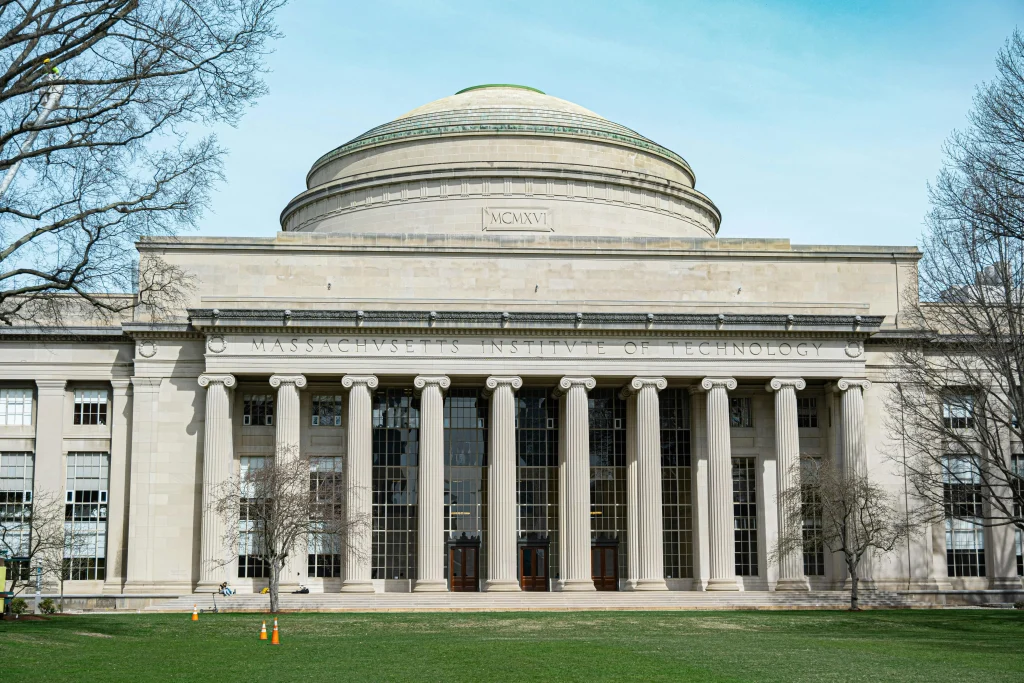If you’re passionate about engineering and technology, you’ve probably heard of MIT (Massachusetts Institute of Technology) and IIT (Indian Institutes of Technology)—two of the most prestigious institutions in the world. But which one is better? And more importantly, which one is the right fit for you?
While MIT is a global leader known for cutting-edge research, IITs are India’s pride, producing some of the world’s brightest engineers. Both institutions have tough admission processes, world-class faculty, and a strong alumni network. However, they follow very different selection criteria, rankings, and academic approaches.
So, if you’ve ever wondered how IIT vs MIT compare in terms of rankings, admission process, and student life, you’re in the right place! Let’s break it down and help you decide which path suits you best.
Table of contents
IIT vs MIT: Quick Comparison
When it comes to top engineering and technology institutes, IIT vs MIT is a common debate among students. Both institutions are prestigious and produce some of the best engineers, scientists, and innovators in the world. However, they differ in admission process, tuition fees, acceptance rates, and job opportunities.
MIT, located in the USA, is known for its cutting-edge research and global exposure, while IITs in India offer excellent education at a much lower cost. Look at a quick comparison of IIT vs MIT.
| Particulars | MIT (Massachusetts Institute of Technology) | IIT (Indian Institute of Technology) |
| Established | April 10, 1861 | September 15, 1956 |
| Location | USA | India |
| Total Students | 11,300 | 10,000 |
| Entrance Exam | SAT & ACT | JEE Advanced & GATE |
| Acceptance Rate | 6.7% | 0.7% to 2% |
| Tuition Fees | INR 65L – INR 70L | INR 2L – INR 10L |
| Avg Salary | INR 99L | INR 20L |
| Institution Type | Private | Government |
| Top Recruiters | Google, Boeing, Raytheon, Lockheed | Microsoft, Tata Steel, Qualcomm, Dell |
Historical Overview of IIT vs MIT

When comparing IIT vs MIT, understanding their historical background helps in evaluating their impact on technology and education. Both institutions have played a significant role in shaping the world of science, engineering, and innovation. While MIT is a single, world-renowned institute in the USA, IIT is a network of elite engineering institutes across India. Let’s take a closer look at their history and contributions.
MIT (Massachusetts Institute of Technology)
Founded in 1861 in Cambridge, Massachusetts, MIT is globally recognized for its research-driven education and innovation. Over the years, it has contributed to groundbreaking advancements in technology, including:
- The World Wide Web – MIT professor Tim Berners-Lee played a key role in developing the web.
- Email Invention – Ray Tomlinson, an MIT graduate, is credited with inventing email.
- BOSE Corporation – Founded by MIT professor Amar Gopal Bose, this company revolutionized sound technology.
IIT (Indian Institutes of Technology)
The first IIT was established in 1956 in Kharagpur with the aim of producing top engineers for India’s development. Today, there are 23 IITs across India, offering world-class technical education. Many IIT graduates have gone on to lead major global companies, such as:
- Sundar Pichai – CEO of Google (IIT Kharagpur)
- Nandan Nilekani – Chairman of UIDAI and co-founder of Infosys (IIT Bombay)
- Narayana Murthy – Co-founder of Infosys (IIT Kanpur)
Unlike MIT, which is a single prestigious institution, IIT is a network of multiple institutes spread across India. This system allows thousands of students to access high-quality engineering education at an affordable cost.
| Parameter | MIT | IIT |
| Founded | 1861 | 1956 |
| Motto | “Mind and Hand” | “Knowledge is the Supreme Goal” |
| Campuses | 1 | 23 |
IIT vs MIT: Acceptance Rates & Admission Process
When comparing IIT vs MIT, one of the biggest differences lies in their admission process and acceptance rates. Both institutions are highly competitive, but the way students get in varies significantly. While MIT follows a holistic approach, considering test scores, extracurriculars, and essays, IIT admissions are purely merit-based, relying on tough entrance exams.
MIT Admissions Process
MIT has a selective admissions process with an acceptance rate of 6.7%. To apply, students must:
- Take the SAT/ACT (for undergraduates) or GRE/GMAT (for postgraduates).
- Have strong extracurricular activities, research projects, and leadership experience.
- Submit an SOP (Statement of Purpose) and LORs (Letters of Recommendation).
- Meet English language requirements like IELTS or TOEFL (for international students).
MIT looks beyond just test scores and considers a student’s overall profile, including innovation, passion, and problem-solving skills.
IIT Admissions Process
IIT admissions are completely exam-based and much tougher in terms of acceptance rates (0.7% – 2%). To get into an IIT, students must:
- Clear JEE Advanced (for undergraduates) or GATE (for postgraduates).
- Rank among the top candidates in these national-level exams.
- Meet category-specific cutoffs and seat availability for different IITs.
JEE Advanced is considered one of the toughest exams in the world, with over a million applicants competing for just a few thousand seats.
IIT vs MIT: Acceptance Rate Comparison
| Institute | Acceptance Rate |
| MIT | 4.5% |
| IIT | 0.5% – 2.6% |
Even though MIT is highly selective, getting into IIT is statistically harder due to the sheer number of applicants and limited seats. However, MIT’s admissions are more flexible, while IIT’s process is rigidly exam-driven.
Also Read:
IIT vs MIT: Academic Curriculum & Top Courses
When comparing IIT vs MIT, the academic curriculum and teaching approach play a significant role in shaping students’ learning experiences. Both institutions excel in engineering, technology, and sciences, but they follow different teaching methodologies. MIT focuses on hands-on learning and innovation, while IIT emphasizes theoretical knowledge and academic excellence.
MIT: A Practical and Research-Driven Approach
MIT is known for its hands-on learning experience, encouraging students to apply theoretical concepts to real-world problems. This practical approach helps MIT graduates excel in cutting-edge industries like AI, aerospace, and biotechnology. The key highlights of MIT’s curriculum include:
- Practical and research-oriented teaching with lab-based learning.
- Small class sizes with a 3:1 student-faculty ratio, ensuring more personalized attention.
- A flexible curriculum with 56 major and 58 minor programs across various disciplines.
- Strong emphasis on entrepreneurship, allowing students to develop startups and innovations.
IIT: Strong Theoretical Foundation and Competitive Exams
IITs follow a structured, theory-heavy curriculum, designed to build a strong academic foundation. While IITs provide high-quality technical education, the learning environment is more exam-focused rather than research-driven. The key features of IIT’s academic structure are:
- More emphasis on theoretical learning with limited hands-on experience.
- Over 250+ B.Tech programs are offered across 23 IITs in India.
- A rigorous evaluation system with continuous assessments, quizzes, and competitive exams.
- Lesser focus on entrepreneurship compared to MIT, though research opportunities are available.
IIT vs MIT: Top Courses & Tuition Fees
| Institute | Top Courses | Avg Tuition Fee |
| MIT | Computer Science, Aerospace Engineering, Electrical Engineering, Architecture | INR 65L – INR 70L |
| IIT | B.Tech, MSc, M.Tech, MBA, Architecture | INR 2L – INR 10L |
Which One is Better?
If you prefer practical exposure, cutting-edge research, and startup opportunities, MIT is the better choice. However, if you want a strong academic foundation with a lower tuition fee, IIT offers excellent value. Ultimately, the decision between IIT vs MIT depends on your career goals, financial situation, and preferred learning style.
Selection Criteria of IIT vs MIT

When applying to top universities, understanding their selection criteria is crucial. IITs and MIT follow different admission processes, each designed to pick the best candidates for their programs. Look at the selection criteria for IIT vs MIT in detail below.
| Criteria | MIT | IIT |
| Entrance Exam | SAT (UG), GRE/GMAT (PG) | JEE Advanced (UG) |
| Academic Performance | High school GPA, subject scores | JEE Advanced ranking |
| Extracurricular Activities | Strongly considered | Not required |
| Statement of Purpose (SOP) | Required for PG admissions | Not required |
| Letters of Recommendation (LORs) | Required for PG admissions | Not required |
| IELTS/TOEFL (for international students) | Required | Not applicable |
| Difficulty Level of Entrance Exam | High (but holistic selection) | Extremely high (rigid selection) |
MIT Selection Process
MIT follows a holistic admission process, meaning it evaluates candidates based on multiple factors, not just test scores. MIT does not have a strict cut-off for test scores but considers the overall profile, achievements, and contributions of the applicant.
Key Requirements for MIT Admission:
- Academic Excellence – High GPA and strong subject scores.
- Entrance Exams:
- Undergraduate (UG): SAT (no minimum requirement, but a high score is preferred).
- Postgraduate (PG): GRE/GMAT (depending on the program).
- Extracurricular Activities: Leadership roles, innovation, and research experience hold significant weight.
- SOP & LORs: Required for PG admissions, these documents help showcase an applicant’s academic and personal strengths.
- IELTS/TOEFL: Mandatory for non-native English speakers.
IIT Selection Process
IITs, on the other hand, rely heavily on the JEE Advanced exam for undergraduate admissions. IIT’s selection process is rigid and highly competitive, with only the top 2% of candidates securing admission.
Key Requirements for IIT Admission:
- JEE Advanced Score:
- Candidates must qualify for JEE Mains first.
- JEE Advanced rank determines admission; cut-offs vary by category (minimum score: 31 to 63).
- No SOP, LORs, or extracurriculars are considered.
- Admission is strictly merit-based, focusing on math, physics, and chemistry performance.
IIT vs MIT: Key Differences in Selection Criteria
- Holistic vs Exam-Based: MIT assesses candidates holistically, while IIT relies solely on JEE Advanced scores.
- Extracurriculars Matter at MIT: Unlike IIT, MIT values extracurricular activities and leadership experience.
- English Proficiency for MIT: MIT requires IELTS/TOEFL, while IIT admissions are conducted in English without an English proficiency test.
- JEE Advanced is Extremely Competitive: The JEE Advanced exam is among the toughest in the world, requiring deep conceptual understanding and problem-solving skills.
Also Read:
- MBBS in Russia 2025: Fees, Eligibility and Top Medical Universities
- Safest Cities in Florida for International Students
IIT vs MIT Rankings
When it comes to engineering and technology education, two institutions often dominate discussions: the Massachusetts Institute of Technology (MIT) and the Indian Institutes of Technology (IITs).
MIT has consistently ranked as the world’s best university, setting the standard for innovation, research, and academic excellence. Meanwhile, IITs have established themselves as India’s top engineering institutions, producing some of the brightest minds in the field. Below we have mentioned the QS World University Rankings 2025 of IIT vs MIT
| Institution | QS World Ranking 2025 |
| Massachusetts Institute of Technology (MIT) | #1 |
| Indian Institute of Technology, Bombay (IITB) | #118 |
| Indian Institute of Technology, Delhi (IITD) | #150 |
| Indian Institute of Technology, Kharagpur (IIT-KGP) | #227 |
| Indian Institute of Technology, Madras (IITM) | #227 |
| Indian Institute of Technology, Kanpur (IITK) | #263 |
| Indian Institute of Technology, Roorkee (IITR) | #335 |
| Indian Institute of Technology, Guwahati (IITG) | #344 |
| Indian Institute of Technology, Varanasi (IIT-BHU Varanasi) | #531 |
| Indian Institute of Technology, Hyderabad (IITH) | #681 – #690 |
Important Facts
- MIT remains the undisputed leader, holding the #1 position globally.
- IIT Bombay (IITB) leads among the IITs, ranking at #118.
- IIT Delhi (IITD) follows closely at #150.
- Other IITs like IIT Madras, IIT Kharagpur, and IIT Kanpur also secure competitive spots.
- While IITs continue to gain international recognition, there is still a significant gap between MIT and IITs in global rankings.
IIT vs MIT: Salary & Placements
When comparing IIT vs MIT, one of the most important factors for students is salary and job opportunities after graduation. Both institutions produce highly skilled engineers, scientists, and business leaders, but MIT graduates tend to secure higher salary packages and global opportunities, while IIT graduates mostly find placements in top Indian and multinational companies.
Average Salary Packages of IIT vs MIT
The salary differences between MIT and IIT are significant, mainly due to MIT’s strong global industry connections and its presence in the USA, where salaries are generally higher. In the table below, you can find the average salary packages of IIT vs MIT.
| Institute | Average Salary (Masters Level) |
| MIT | INR 99L per year |
| IIT | INR 20L per year |
- MIT graduates often work in high-paying industries like AI, aerospace, and finance.
- IIT graduates secure excellent salaries in India but may earn less compared to MIT graduates internationally.
Top Recruiters of IIT vs MIT
MIT’s strong global presence attracts top multinational companies, offering higher salaries and opportunities in Silicon Valley, Wall Street, and major tech hubs worldwide. IITs, on the other hand, have strong domestic placements and growing international opportunities, especially in software, consulting, and core engineering sectors. Below are the top recruiters of IIT vs MIT:
| Institute | Top Companies Hiring |
| MIT | Google, Boeing, Lockheed Martin, Samsung, Intel |
| IIT | Microsoft, Tata Steel, Qualcomm, Dell, Goldman Sachs |
Which One Offers Better Placements?
- If your goal is to work for top global companies with high salary packages, MIT is the better choice.
- If you want excellent job opportunities in India with a strong alumni network and lower education costs, IIT is a great option.
There is no single winner in the IIT vs MIT debate—it all depends on your goals! Both IIT and MIT open doors to incredible opportunities. Your choice should depend on your career aspirations, financial considerations, and academic strengths. No matter where you study, your dedication and hard work will determine your success!
Hope you liked reading our blog about IIT vs MIT. For a stress-free stay during your study abroad adventure, choose Fly Homes. Call 1800572118 to reserve your ideal accommodation abroad with ease.
FAQs
It depends on your goals. IITs are top institutes in India, while MIT is a global leader in science and technology. MIT offers better research opportunities, funding, and global exposure, but IITs provide quality education at a lower cost.
Both are very competitive. IITs accept around 1% of JEE Advanced candidates. MIT’s acceptance rate is around 4%, but you also need a strong academic profile, research work, and extracurriculars.
MIT graduates often get higher salaries and better global opportunities. Top companies like Google, Tesla, and NASA recruit from MIT. IITs also offer good placements, but mostly in India-based companies.
Yes, but it is rare. You can apply for a master’s or PhD at MIT after studying at IIT. MIT also offers exchange programs for research collaborations.
Yes, many Indian students study at MIT. You need strong academic records, SAT/ACT scores, research projects, and an impressive application.
MIT has better research opportunities due to its advanced labs, funding, and collaborations. IITs have good research but less funding and fewer global collaborations.
If you can afford it or get a scholarship, MIT offers better exposure, research, and career opportunities. However, IITs provide quality education at a lower cost, making them a great option for students in India.
Yes! You can apply for IITs through JEE Advanced and MIT through SAT/ACT and TOEFL. Many students try both to keep their options open.
MIT has a more diverse and international environment, with clubs, research groups, and global networking. IITs also have a great student life with cultural fests, tech clubs, and strong peer networks.
If you want affordable education in India, choose IIT. If you want global exposure, cutting-edge research, and top placements, MIT is better. It depends on your budget, career goals, and interests.
IITs are significantly more affordable due to government subsidies, while MIT is expensive but offers need-based financial aid.
While IITs are highly respected in India and among tech companies globally, MIT has a far stronger international reputation and global academic recognition.
MIT leads in CS research, AI, and machine learning globally. However, IITs like Bombay and Delhi also offer excellent CS programs for students focused on the Indian job market.
Yes. MIT offers need-based financial aid to international students, including Indians, which can cover full tuition and living expenses.
No. While expensive, MIT provides need-based aid. Many students from middle-class and low-income families study there with little or no cost.
Follow Us on Social Media




























